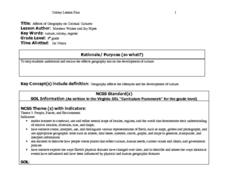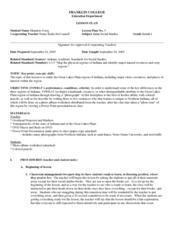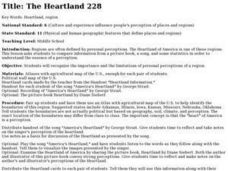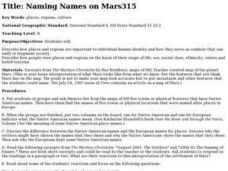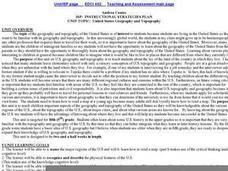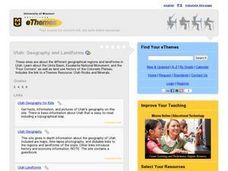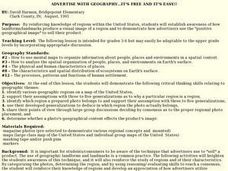Curated OER
Time Zones
Third graders have a greater understanding of time zones, explain the basic history and purpose in the creation of time zones, and use time zone maps to calculate the time/day in a certain area.
Curated OER
How Does Climate Influence Civilization
Students demonstrate their knowledge of the Earth's systems. In this climate lesson students identify the climate of a chosen area and the effects it has on the lifestyles of those living there.
Curated OER
Chapter 8 Key Terms
In this science learning exercise, students locate and identify various vocabulary terms related to the environment and earth science. There are 27 words located in the puzzle.
Curated OER
Affects of Geography on Colonial Cultures
Sixth graders examine the effects of geography on the development of culture. They discuss how geography can affect the lifestyles and development of a society's culture. Students examine the geography and climate of New England and the...
Curated OER
Treasure Hunt Region
Students are introduced to new geography related vocabulary words. In groups, they focus on a different region of the school and develop a new name for it. They create a treasure map for another group to use in the region of the school...
Curated OER
IDP Introduction
Fourth graders examine the three regions of North Carolina through class discussion of favorite places in the state and a review game based on the game of twister. The different colors on the twister sheet represent the different...
Curated OER
The Great Lakes Plain Regions
Fourth graders explore the Great Lakes Plain region of Indiana. They discuss the key differences in the three regions of Indiana. Students discuss the landmarks, resources and other attributes of the Great Lakes Plain region and they...
Curated OER
The Regions In Which I Live
Learners investigate different regions. Beginning with the idea that a neighborhood is a region, students explore maps to discover that towns, states, and countries can also be considered regions. Learners create a book, with...
Curated OER
My Neighborhood
Second graders discuss maps and identify boundaries found on a map. They walk through their school and nearby neighborhood and collect information regarding important features of the area.
Curated OER
Korean Road Trip
Students research the geographical regions of Korea. They plan a hypothetical road trip that could be taken in the country. Students also write a study journal for the trip that records possible events that could take place.
Curated OER
Dr. Green's Rainforest Mystery
Third graders create a brochure describing all of the information researched about a specific animal. Using this information, create a 3-D model of the animal and its habitat that could later be used to design an appropriate living...
Curated OER
Quarters: Arkansas and Vermont
Students compare and contrast the natural resources of Arkansas and Vermont and the design of the quarter. Students infer from their Venn diagrams and maps how regions differ across the United States.
Curated OER
The Heartland
Students note how personal perceptions influence the understanding of what a region. They look at an agricultural map of what is considered to be the Heartland of the US. They read the words to George Strait's, America's Heartland to see...
Curated OER
Naming Names on Mars
Students examine maps of New Hampshire to determine town and physical features that have Native American and European names. They discuss the reasons for these names to determine what influences the naming of places. They name geographic...
Curated OER
Rapping Regions in America
Students determine what designates a place as a region. They apply their criteria for a region to the US map. They work in groups to write a rap about their region that describes its organization, type and structure.
Curated OER
Local Area - What Is a Region?
Students examine the physical characteristics of the Connecticut River Valley. They analyze maps and pictures, identify physical characteristics of the region, and color in the Connecticut River on a map.
Curated OER
Making a Region Map of a State
Fourth graders create salt maps of a state and indicate its regions. They include topographical elements including mountains, valleys, lowlands and major water bodies and a compass rose.
Curated OER
United States Geography and Topography
Fifth graders recognize the major regions of the US while reading a map. Students study the physical features of the US. Student research and report on states and their capitols.
Curated OER
Equivalent Fractions
Students study the concept of equivalent fractions using naming concepts.
Curated OER
Equal Shares for Each Province
Students investigate fairness, equality, and representation in the Canadian Parliament. The concepts are explored within the context of equal distribution of boxes of cereal to various groups.
Curated OER
Mapping the United States
Fifth graders research assigned states. They identify the capital, the climate, industries,rivers, and native animals.
Curated OER
Utah: Geography
Students research the different geographical regions and landforms in Utah.
Curated OER
Advertise With Geography...it's Free And It's Easy!!
Students establish awareness of how landforms/landmarks produce a visual image of a region and demonstrate how advertisers use the "positive geographical image" to sell their product by creating their own advertisements.





